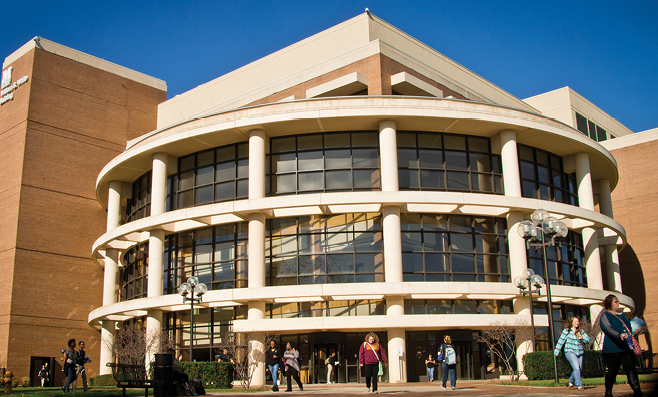- Home
- Media Kit
- Current Issue
- Past Issues
- Ad Specs-Submission
- Ad Print Settings
- Reprints (PDF)
- Photo Specifications (PDF)
- Contact Us


![]()
ONLINE

A Complete
Educational Experience
Editors’ Note
Susan Borrego began service in her current role in 2014. Most recently, Borrego served as Vice President for Enrollment Management, Planning, and Student Affairs at California State University, Dominguez Hills. Previously, she was Vice President for Student Affairs at CSU Monterey Bay, and Assistant Vice Chancellor for Student Affairs and Associate Vice Chancellor/Dean of Students at the University of Arkansas. She has taught at the University of Southern California and CSU-Fullerton. Borrego received her B.A. degree in speech and communication from Northwest Nazarene College. She went on to achieve her M.A. in Social Science/Student Development from Azusa Pacific University, and her Ph.D. in Education from Claremont Graduate School.
Institution Brief
Founded in 1956 on a commitment to bring a quality Michigan education to Flint and the surrounding area, UM-Flint (umflint.edu) has welcomed a record number of students into their classrooms, equipping them with the knowledge, experiences, and skills to make lasting contributions to the businesses, organizations, and communities they help shape. More than 45,000 students have graduated from UM-Flint.
When the opportunity presented itself to lead UM-Flint, what made you feel it was the right fit?
At its core, a regional comprehensive university has two primary functions: to provide access to top-quality degrees in the region and to enhance the quality of life in the region. My work has been centered on those goals my entire career.

The campus of the University of Michigan-Flint
When I came to interview for this role, there was so much good work going on at the University and the people of Flint won me over. I remember reading about Phil Hagerman bringing interns into Flint because he thought that, once they saw Flint, they would want to stay here. Here was a pharmacist doing what we do in education — bringing students into Flint.
I kept hearing the name Bobby Mukkamala. Here was a doctor, married to a doctor, who came back to Flint and started making investments. He was one of several long-time Flint residents investing in the community. The fact that people are invested in the community made the opportunity to serve at the anchor institution downtown too good to pass up.
We have been in the community 60 years, we provide access to quality degrees, we have a strong endowment, and great potential to increase enrollment. It seemed like a perfect match for the work to which I’m committed.
How important is it that UM-Flint is adapting its curriculum and providing education in areas such as STEM?
It’s critical for the region.
STEM enrollment grew by over 50 percent here in the last decade. We’re excited about our Murchie Science Building expansion project. We’re also interested in STEAM, which includes a core group of skills from the arts that enhance the ability to interact, work across differences, and communicate effectively. In this region there’s a need for expanding healthcare professionals, and our healthcare majors are also growing.
We offer a complete educational experience.
Do the young people of Flint understand the strength of the education that is available to them in the city?
I hear frequently that people are grateful that a University of Michigan campus is here in Flint. I believe students here understand the strength of our degree. We must continue taking a more active role in telling the story of the good work our students, faculty and staff are doing.
Two years ago, we added new merit scholarships to compete for top students who receive offers from other schools, and we’ll continue to work on ‘growing our own,’ working with community partners to create a college going culture.
Not enough of our Flint students are graduating from college, so we’re really working throughout the community on expanding these opportunities.
How critical is the role the college plays within the overall Flint community?
One of the differences about UM-Flint is that the community reached out to the University of Michigan to tell them they wanted a campus. The people of Flint proposed and approved a $1.6 million bond issue with an additional $1 million contributed from Charles Stewart Mott. That founded UM-Flint.
The institution was integrated with the community from the get-go. The university contributes $64m annually to the community. Beyond the fiscal contribution, adds significantly to the quality of life. We enhance economic development; and the very nature of a college degree is about talent development.
Through community-based research, internships, and volunteer work our students get hands-on opportunities to practice what they’re learning, which provides service to the community. The richness of a student’s learning experience is greatly enhanced by working on issues facing that community in partnership with the community.
Will you discuss the initiative to bring veterans into the community?
UM-Flint’s VBSN program is dedicated to strengthening the healthcare workforce through the recruitment, licensure and employment of U.S. veterans. This accelerated program focuses on reducing barriers that interfere with the transition of veterans into nursing and building on their prior military healthcare training and related experience.
We’ve seen much success, as evidenced by the recent receipt of a $100,000 grant to enhance it even further.•